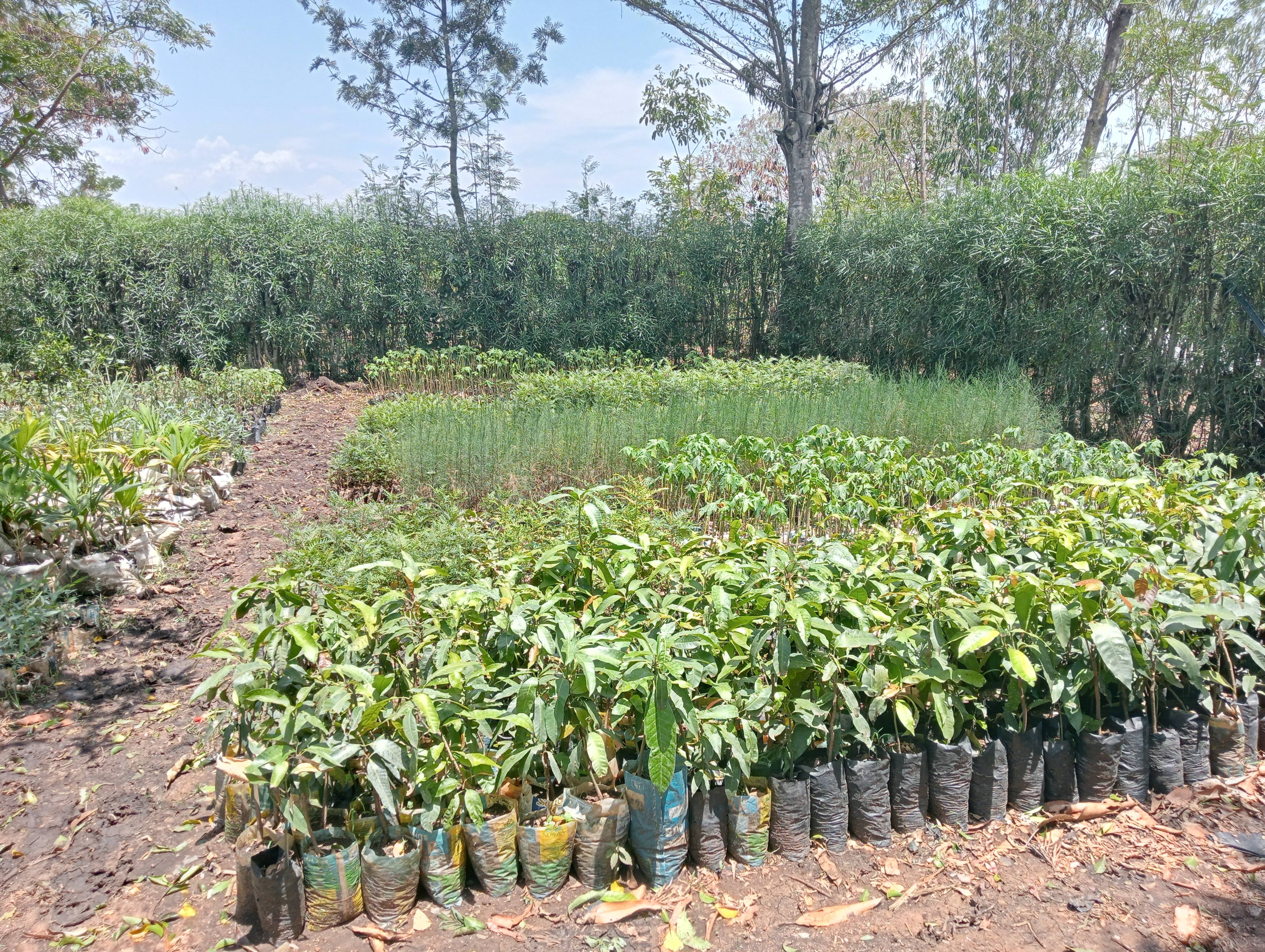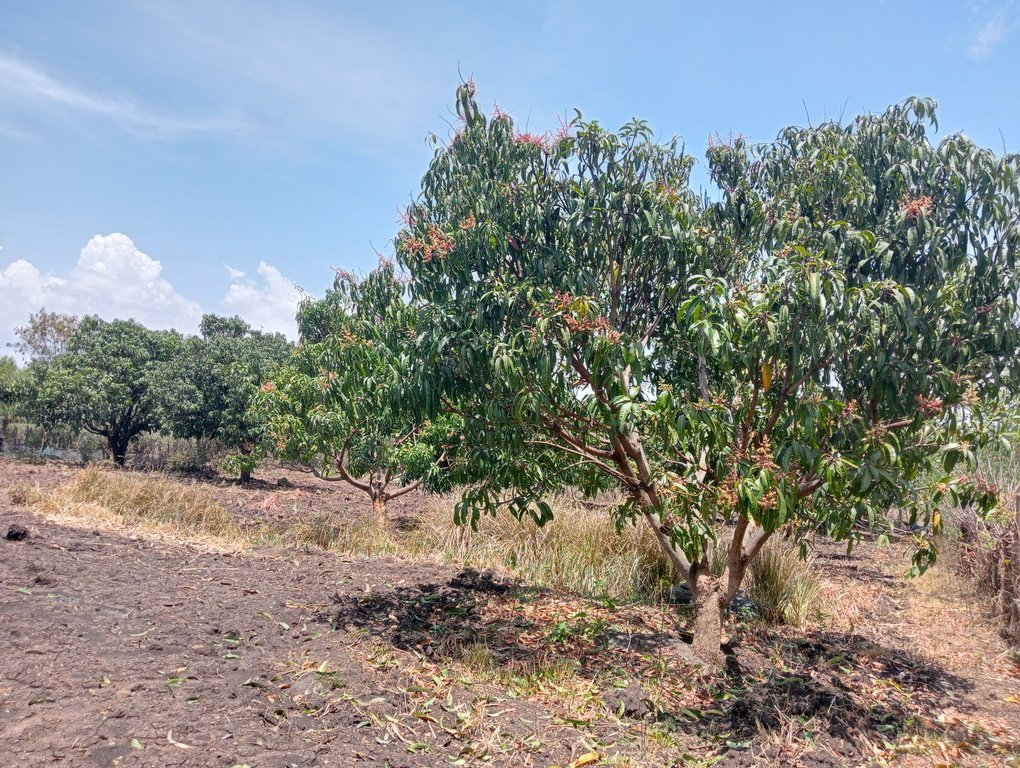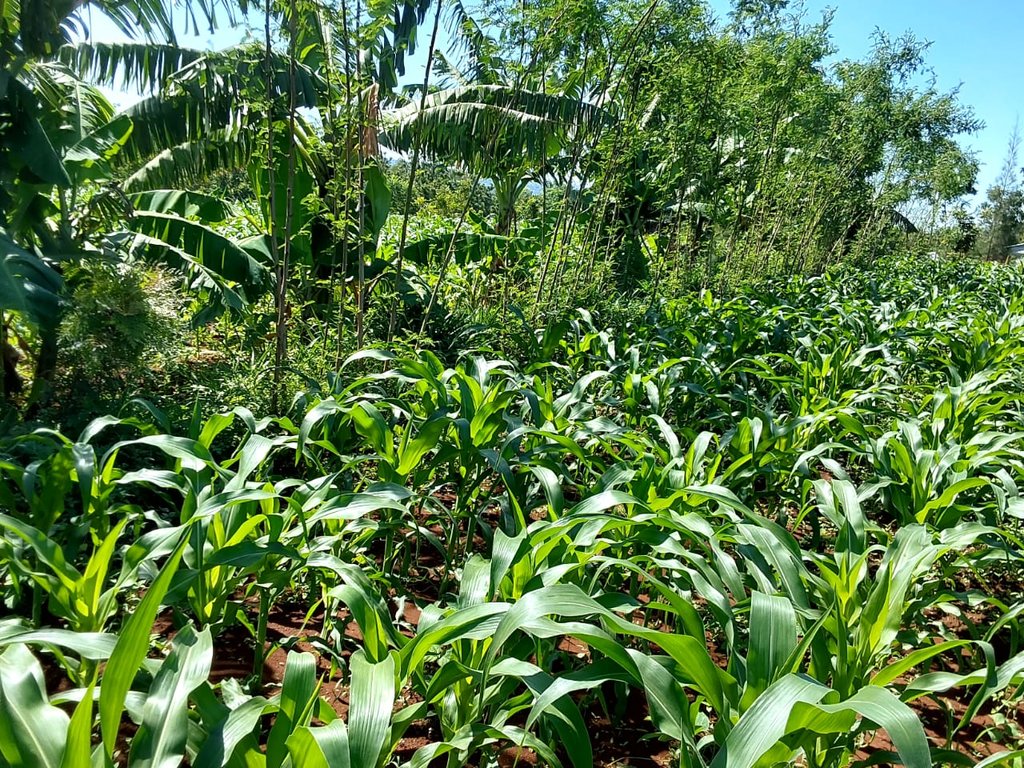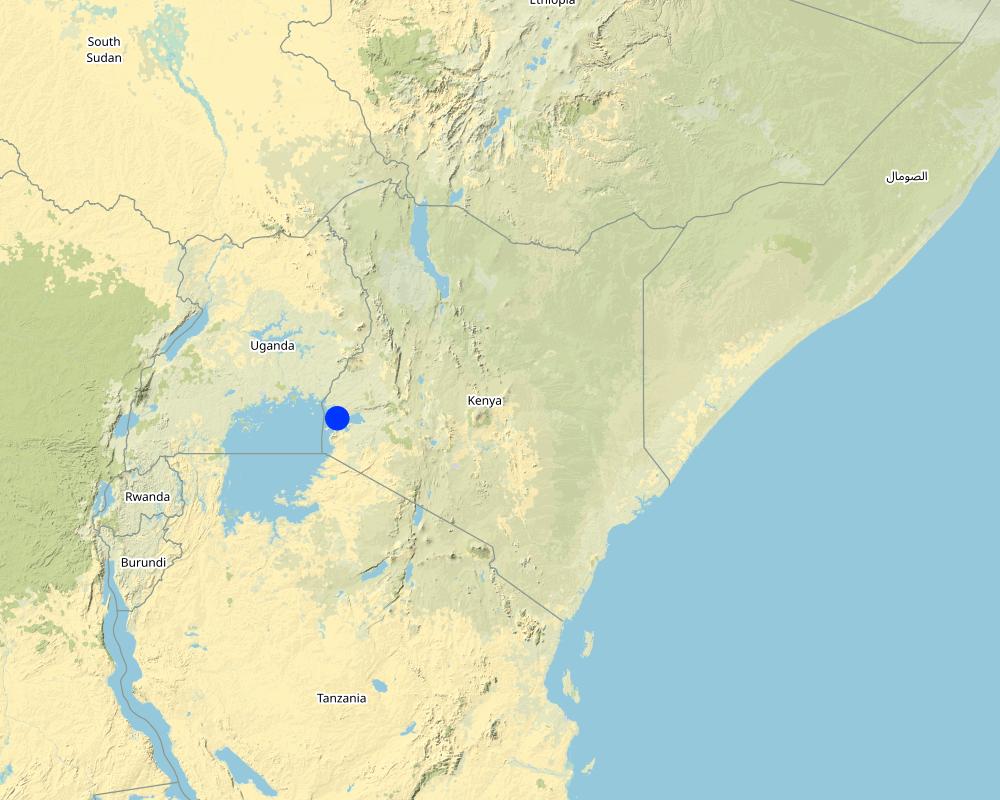Promotion of different trees for agroforestry [เคนยา]
- ผู้สร้างสรรค์:
- การอัพเดท:
- ผู้รวบรวม: William Akwanyi
- ผู้เรียบเรียง: JARED AYIENA, Innocent Faith, Noel Templer, JUSTINE OTSYULA
- ผู้ตรวจสอบ: William Critchley, Rima Mekdaschi Studer
approaches_6706 - เคนยา
ดูส่วนย่อย
ขยายทั้งหมด ย่อทั้งหมด1. ข้อมูลทั่วไป
1.2 รายละเอียดที่ติดต่อได้ของผู้รวบรวมและองค์กรที่เกี่ยวข้องในการประเมินและการจัดเตรียมทำเอกสารของแนวทาง
วิทยากรหลัก
ผู้ใช้ที่ดิน:
Omolo Charles Abok
+254 728 135152
charlesabok88@gmail.com
Welthungerhilfe farmer
Nyaguda Village, South Sakwa Ward, Bondo Sub-county in Siaya County
เคนยา
ผู้เชี่ยวชาญ SLM:
ผู้เชี่ยวชาญ SLM:
ชื่อของโครงการซึ่งอำนวยความสะดวกในการทำเอกสารหรือการประเมินแนวทาง (ถ้าเกี่ยวข้อง)
Soil protection and rehabilitation for food security (ProSo(i)l)ชื่อของโครงการซึ่งอำนวยความสะดวกในการทำเอกสารหรือการประเมินแนวทาง (ถ้าเกี่ยวข้อง)
Deutsche Gesellschaft für Internationale Zusammenarbeit (GIZ)ชื่อของโครงการซึ่งอำนวยความสะดวกในการทำเอกสารหรือการประเมินแนวทาง (ถ้าเกี่ยวข้อง)
Alliance Bioversity and International Center for Tropical Agriculture (Alliance Bioversity-CIAT) - เคนยา1.3 เงื่อนไขที่เกี่ยวข้องกับการใช้ข้อมูลที่ได้บันทึกไว้ผ่านทาง WOCAT
วันที่เก็บรวบรวมข้อมูล (ภาคสนาม):
01/03/2023
ผู้รวบรวมและวิทยากรหลักยอมรับเงื่อนไขเกี่ยวกับการใช้ข้อมูลที่ถูกบันทึกผ่านทาง WOCAT:
ใช่
1.4 การอ้างอิงถึงแบบสอบถามเรื่องเทคโนโลยี SLM
2. คำอธิบายของแนวทาง SLM
2.1 การอธิบายแบบสั้น ๆ ของแนวทาง
Promoting the values of different trees and their benefits in agroforestry contributes to increased adoption by farmers.
2.2 การอธิบายอย่างละเอียดของแนวทาง
การอธิบายอย่างละเอียดของแนวทาง:
Agroforestry involves the integration of trees and/ or shrubs in a farming system on the same land where crops or pastures are grown. It offers significant environmental, economic, and social benefits. Agroforestry also enables farmers to diversify their on-farm income. Furthermore, it contributes to climate change adaptation and mitigation and improves the environment within the farm, especially soils. However, not every farmer is willing to adopt agroforestry. Trees and shrubs take up space that would have been dedicated to crops or pasture: this is a primary reason why farmers are not willing to plant trees and/ or shrubs on their farms. Similarly, many farmers do not clearly understand the values of some trees and shrubs. It is, therefore, essential to overcome the barriers to adopting agroforestry among farmers.
The ProSoil project has created awareness among farmers in Kakamega, Bungoma, and Siaya Counties about the more efficient and profitable tree and shrub-based value chains to attract farmers to agroforestry and pave the way for greater uptake. The farmers were targeted through their groups. Each group consisting of about 25 farmers, and with at least 30% women. Farmers are introduced to trees and/ or shrubs that blend well with their farming system. In addition, farmers choose trees and/ or shrubs based on the sizes of their farming land and their respective benefits. Farmers can plant trees and shrubs as single stands or integrate them into farming land. They can also plant agroforestry trees around their homesteads. A single stand can have, for example, mangos, avocados, and/or other trees. The project advocates for a more sustainable win-win approach where farmers and the environment benefit from an agroforestry system. Some of the benefits of trees and shrubs, as highlighted by the project, include the following:
a) Soil erosion control: trees and shrubs are planted on across slopes to slow down runoff and trap sediment (consequently, accumulating soil – this can form terraces after several years). Their roots hold the soil in place and reduce the impact of moving water.
b) Stabilising stream banks and gullies (e.g., Leucaena leucocephala, Sesbania grandiflora, Moringa oleifera, etc.): help to reduce soil erosion along streams and gullies when planted at the medium- to high-level watermark. Their roots hold the soil in place and reduce the impact of moving water.
c) Green manure (e.g., Sesbania sesban, Tithonia sp., etc.): from foliage and twigs.
d) Live fences (e.g., Tithonia sp.): used as boundaries to provide privacy and protection from browsing animals.
e) Windbreakers (e.g., Casuarina equisetifolia, Grevillea robusta, Leucaena leucocephala, etc.): planted in one or two rows/ lines closely together along the edges of the farm and perpendicular to winds to protect crops, soils, and structures from the detrimental effects of wind.
f) Fodder (e.g., Grevillea robusta, Sesbania sesban, Leucaena leucocephala, etc.): foliage is food for livestock.
g) Food (e.g., mangoes, avocadoes, etc.): a human food source.
h) Carbon sequestration (all trees and shrubs): they act as carbon sinks by capturing carbon dioxide from the atmosphere.
2.3 รูปภาพของแนวทาง
2.5 ประเทศ ภูมิภาค หรือสถานที่ตั้งที่ได้นำแนวทางไปใช้
ประเทศ:
เคนยา
ภูมิภาค/รัฐ/จังหวัด: :
Siaya County, Nyanza Region
ข้อมูลเฉพาะเพิ่มเติมของสถานที่ตั้ง:
Nyagudha village, South Sakwa Ward, Bondo Sub-county
Map
×2.6 วันที่เริ่มต้นและสิ้นสุดของแนวทาง
ระบุปีที่เริ่ม:
2019
2.7 ประเภทของแนวทาง
- Both traditional practice and project based: farmers have been growing trees and shrubs on their farms but the ProSoil project introduced them to more beneficial trees and better ways of producing the trees e.g., through grafting.
2.8 เป้าหมายหรือวัตถุประสงค์หลักของแนวทาง
Aim: To promote the adoption of agroforestry.
Objectives:
1) To introduce farmers to the diverse benefits of trees in farming.
2) To encourage farmers to incorporate trees and/ or shrubs in their farming.
2.9 เงื่อนไขที่เอื้ออำนวยหรือเป็นอุปสรรคต่อการนำเทคโนโลยีภายใต้แนวทางนี้ไปปฏิบัติใช้
บรรทัดฐานและค่านิยมทางสังคม วัฒนธรรม ศาสนา
- เอื้ออำนวย
Trees play a central role in the socio-cultural lives of people and are used for a wide range of cultural practices.
- เป็นอุปสรรค
Cultural beliefs: e.g., women are not supposed to plant (some) trees as this is considered a male role. This hinders women from full participation in agroforestry activities.
การมีไว้ให้หรือการเข้าถึงแหล่งการเงินและบริการ
- เป็นอุปสรรค
Some farmers do not have adequate financial resources to purchase seedling of some tree and shrub seedlings.
การร่วมมือหรือการทำงานประสานกันของผู้ลงมือปฏิบัติ
- เอื้ออำนวย
Other institutions such as the county governments pass agroforestry information to farmers through the public agricultural extension officers. County governments are important collaborators in the ProSoil project.
กรอบแนวทางในการดำเนินการด้านกฎหมาย (การถือครองที่ดิน สิทธิในการใช้ที่ดินและน้ำ)
- เป็นอุปสรรค
Trees and/ or shrubs take several years to mature. This is closely linked to land tenure since most people would prefer to establish trees only on their farms.
นโยบาย
- เอื้ออำนวย
Kenya's 10 Percent Tree Cover Strategy includes the component of promoting farm forestry through various platforms e.g., radio and TV.
การกำกับดูแลที่ดิน (การตัดสินใจ การนำเอาไปปฏิบัติใช้ และการบังคับใช้)
- เป็นอุปสรรค
Women and youth have little or no control over land in most communities. Hence, they cannot make decisions to plant (some) trees on the family land.
ความรู้เกี่ยวกับ SLM การเข้าถึงการสนับสนุนด้านเทคนิค
- เอื้ออำนวย
ProSoil project has supported the dissemination of information about the importance of agroforestry as an SLM technology and how to propagate trees e.g., through grafting. As a result, some farmers have established trees nurseries.
ตลาด (จัดซื้อปัจจัยนำเข้า ขายผลิตภัณฑ์) และราคา
- เอื้ออำนวย
The increasing awareness about the benefits of many trees has led to an increase in the demand for the different products from the trees e.g., fruits, honey, medicines, etc. This potential of trees to generate income encourages farmers to plant trees.
3. การมีส่วนร่วมและบทบาทของผู้มีส่วนได้ส่วนเสียที่เกี่ยวข้อง
3.1 ผู้มีส่วนได้ส่วนเสียที่เกี่ยวข้องในแนวทางนี้และบทบาท
- ผู้ใช้ที่ดินระดับท้องถิ่นหรือชุมชนระดับท้องถิ่น
Farmers, farmer groups (women, youth, and mixed gender)
Recipients of the trainings in agroforestry.
- ผู้เชี่ยวชาญ SLM หรือที่ปรึกษาการเกษตร
GIZ ProSoil project SLM specialists; specialists from the implementing partner, Welthungerhilfe; and county SLM specialists from the departments of agriculture and environment.
Provides technical advice to the farmers and link farmers to markets and tree nurseries.
- รัฐบาลระดับท้องถิ่น
County government agriculture and environment departments
Provides technical advice to the farmers and link farmers to markets and tree nurseries.
- องค์การระหว่างประเทศ
GIZ
Financial support to the technical team and farmers during capacity building.
ถ้ามีผู้มีส่วนได้ส่วนเสียหลายคนที่เกี่ยวข้องให้ระบุหน่วยงานตัวแทน:
GIZ
3.2 การเกี่ยวข้องของผู้ใช้ที่ดินระดับท้องถิ่นหรือชุมชนระดับท้องถิ่นในช่วงต่างๆของแนวทาง
| ความเกี่ยวข้องของผู้ใช้ที่ดินระดับท้องถิ่นหรือชุมชนระดับท้องถิ่น | ระบุผู้ที่มีส่วนเกี่ยวข้องและอธิบายกิจกรรม | |
|---|---|---|
| การริเริ่มหรือการจูงใจ | ระดมกำลังด้วยตนเอง | Farmers involved in the training in agroforestry. |
| การวางแผน | ปฏิสัมพันธ์ | Farmers consulted on where and when to establish demos of agroforestry tree nurseries. |
| การดำเนินการ | ระดมกำลังด้วยตนเอง | Although farmers are advised which trees are better for their farms, they are the final decision makers on which trees and shrubs to incorporate in their farms. |
| การติดตามตรวจสอบหรือการประเมินผล | ไม่ลงมือ | Interviews with implementing farmers. |
| ไม่มี |
3.3 แผนผังแสดงขั้นตอนการทำงาน (ถ้ามี)
คำอธิบาย:
The ProSoil project (GIZ and WHH) provides financial (transport reimbursement) and material (seedlings) support to farmers through their groups (Ndati Development Self-Help Group). The project also facilitates the county departments of Agriculture and Environment to train farmers in agroforestry and increase their awareness about the socio-economic and ecological benefits of different trees. at the farm.
ผู้เขียน:
William Akwanyi
3.4 การตัดสินใจเลือกใช้เทคโนโลยี SLM
ระบุผู้ที่ทำการตัดสินใจเลือกเทคโนโลยีมากกว่าหนึ่งวิธีไปปฏิบัติใช้:
- ผู้ใช้ที่ดินเป็นผู้ตัดสินใจหลัก โดยการสนับสนุนจากผู้เชี่ยวชาญ SLM
การอธิบาย:
The ProSoil project team provides technical support on the selection of trees based on the diverse needs of farmers, and the sizes and locations of their farms. However, the final decision to plant which type(s) of trees and where to plant them at the farm rests with the farmer.
ระบุว่าการตัดสินใจตั้งอยู่บนพื้นฐานของ:
- การประเมินความรู้ SLM ที่ได้ทำการบันทึกไว้เป็นอย่างดี (การใช้ข้อมูลในการตัดสินใจ)
- ประสบการณ์และความคิดเห็นส่วนตัว (ไม่ได้ลงบันทึกไว้)
4. การสนับสนุนด้านเทคนิค การสร้างขีดความสามารถ และการจัดการด้านความรู้
4.1 การสร้างขีดความสามารถ / การอบรม
ได้มีการจัดอบรมให้แก่ผู้ใช้ที่ดินหรือผู้มีส่วนได้ส่วนเสียคนอื่น ๆ หรือไม่:
ใช่
ให้ระบุว่าใครเป็นผู้ได้รับการอบรม:
- ผู้ใช้ที่ดิน
รูปแบบการอบรม:
- เกษตรกรกับเกษตรกร
- ใช้พื้นที่ทำการสาธิต
หัวข้อที่พูด:
1. Different trees in agroforestry and their benefits
2. Tree nursery management
3. Grafting
4. Agroforestry systems
5. Value addition to agroforestry products and marketing
ความคิดเห็น:
Welthungerhilfe contracted SLM specialists from the county departments of agriculture and environment to train farmers and carry out demonstrations on tree planting and value addition in their groups during sessions organized by the ProSoil project. Other farmers are learning from the trained farmers. These specialists also advice farmers during farm visits.
4.2 การบริการให้คำแนะนำ
ผู้ใช้ที่ดินมีการเข้าถึงการรับบริการให้คำปรึกษาหรือไม่:
ใช่
ระบุว่ามีบริการให้คำปรึกษาหรือไม่:
- ไปเยี่ยมชมสถานที่
- ที่ศูนย์ถาวร
- Specific locations where the farmers interact with the technical officers and at their farms.
การอธิบาย/แสดงความคิดเห็น:
Farmers were trained in their groups at specific venues during sessions organized by the ProSoil project/ WHH. Other farmers are learning from the trained farmers. These specialists also advice farmers during farm visits.
4.3 การเสริมความแข็งแกร่งให้กับสถาบัน (การพัฒนาองค์กร)
สถาบันได้รับการจัดตั้งขึ้นมาหรือเสริมความแข็งแกร่งโดยแนวทางนี้หรือไม่:
- ใช่ เล็กน้อย
ระบุระดับของสถาบันที่ได้รับการเสริมความแข็งแกร่งหรือจัดตั้งขึ้นมา:
- ท้องถิ่น
อธิบายถึงสถาบัน บทบาทและความรับผิดชอบ สมาชิก เป็นต้น:
Farmers have formed groups such as Ndati Development Self-Help Group e.g., to run tree nurseries. The groups consist of several men and women of diverse ages. Farmers develop funding and other support proposals through the groups.
ระบุประเภทของการให้ความช่วยเหลือสนับสนุน:
- การสร้างขีดความสามารถ / การอบรม
- อุปกรณ์
ให้รายละเอียดเพิ่มเติม :
Trainings in agroforestry, markets, tree propagation, etc.
Nursery materials and equipment including water tanks, seeds and grafting tools
4.4 การติดตามตรวจสอบและประเมินผล
การติดตามตรวจสอบและประเมินผลเป็นส่วนหนึ่งของแนวทางหรือไม่:
ใช่
ความคิดเห็น:
GIZ and Welthungerhilfe regularly follows up with farmers to check on the implementation of technologies promoted under this approach.
ถ้าตอบว่าใช่ แสดงว่าการจัดเตรียมเอกสารนี้มุ่งหวังที่จะเอาไปใช้สำหรับการติดตามตรวจสอบและประเมินผลใช่หรือไม่:
ไม่ใช่
ความคิดเห็น:
This documentation in intended for keeping a record of SLM technologies and approaches.
4.5 การวิจัย
การวิจัยเป็นส่วนหนึ่งของแนวทางหรือไม่:
ไม่ใช่
5. การสนับสนุนด้านการเงินและวัสดุอุปกรณ์
5.1 ระบุงบประมาณประจำปีสำหรับแนวทาง SLM นี้
ถ้าหากว่างบประมาณประจำปีไม่เป็นที่ทราบแน่นอน ให้ระบุช่วงลงไป:
- 10,000-100,000
แสดงความคิดเห็น (แหล่งของการระดมทุน ผู้บริจาคคนสำคัญ):
ProSoil project facilitated trainings on the SLM technologies under this approach, including transport reimbursement to farmers and trainers and remuneration to trainers during trainings. Farmers meet the costs of land preparation, acquiring seeds and seedlings, planting trees, and managing the trees. The stated budget is for training one farmer group of about 25 farmers.
5.2 การสนับสนุนด้านการเงิน / วัสดุอุปกรณ์ให้แก่ผู้ใช้ที่ดิน
ผู้ใช้ที่ดินได้รับการสนับสนุนด้านการเงิน / วัสดุอุปกรณ์ไปปฏิบัติใช้เทคโนโลยีหรือไม่:
ใช่
ถ้าใช่ ให้ระบุประเภทของการสนับสนุน เงื่อนไขและผู้จัดหามาให้:
The ProSoil project through Welthungerhilfe supported the farmers (through their group) with trainings and setting up demo plots.
5.3 เงินสนับสนุนสำหรับปัจจัยนำเข้า (รวมถึงแรงงาน)
- ไม่มี
ถ้าแรงงานโดยผู้ใช้ที่ดินเป็นปัจจัยนำเข้าที่มีอยู่มากมาย ระบุด้วยว่าเนื่องจาก:
- สมัครใจ
ความคิดเห็น:
Farmers voluntarily provided labour at the demonstration plot and on their own land.
5.4 เครดิต
มีการจัดหาเครดิตมาให้ภายใต้แนวทาง SLM หรือไม่:
ไม่ใช่
5.5 แรงจูงใจหรือเครื่องมืออื่น ๆ
แรงจูงใจหรือเครื่องมืออื่น ๆ ได้ถูกนำไปใช้ส่งเสริมการใช้เทคโนโลยี SLM หรือไม่:
ใช่
ถ้าใช่ ระบุ:
Linkage to markets for the tree and shrub products. GIZ, WHH, and the county department of agriculture and environmental invite farmers to field days where the farmer can link up with potential markets.
6. การวิเคราะห์ผลกระทบและการสรุป
6.1 ผลกระทบของแนวทาง
ทำให้ผู้ใช้ที่ดินระดับท้องถิ่นมีอำนาจขึ้น ปรับปรุงการเข้าร่วมของผู้มีส่วนได้ส่วนเสียให้ดีขึ้นหรือไม่:
- ไม่ใช่
- ใช่ เล็กน้อย
- ใช่ ปานกลาง
- ใช่ อย่างมาก
Farmers were empowered with skill on how to propagate trees. Stakeholder participation was enhanced through collaboration with other actors such as the county government.
ช่วยในการตัดสินใจโดยดูจากหลักฐาน ได้หรือไม่:
- ไม่ใช่
- ใช่ เล็กน้อย
- ใช่ ปานกลาง
- ใช่ อย่างมาก
Farmers were motivated to plant some trees and shrubs on their farms after benchmarking farms which had established and benefited from similar trees.
ช่วยให้ผู้ใช้ที่ดินนำเอาเทคโนโลยี SLMไปใช้และบำรุงรักษาสภาพไว้ได้หรือไม่:
- ไม่ใช่
- ใช่ เล็กน้อย
- ใช่ ปานกลาง
- ใช่ อย่างมาก
After learning about the importance of different trees, farmers incorporated trees in their farming systems e.g., planting trees and/ or shrubs in vegetative cross slope barriers.
ปรับปรุงความรู้และความสามารถของผู้ใช้ที่ดินในการดำเนินการ SLM หรือไม่:
- ไม่ใช่
- ใช่ เล็กน้อย
- ใช่ ปานกลาง
- ใช่ อย่างมาก
The trainings given to farmers included how to plant different trees and areas within a farm setting where such trees are best suited. This knowledge was helpful in the incorporation of trees in the implementation of vegetative cross-slope barriers, green manure cover crops, and retention ditches.
ช่วยบรรเทาความขัดแย้งหรือไม่:
- ไม่ใช่
- ใช่ เล็กน้อย
- ใช่ ปานกลาง
- ใช่ อย่างมาก
Planting of quick growing shrubs has provided source of fuel wood at the household level reducing conflicts resulting in neighbouring farmers invading farms for fuel wood
นำไปสู่ความมั่นคงด้านอาหารหรือปรับปรุงโภชนาการให้ดีขึ้น:
- ไม่ใช่
- ใช่ เล็กน้อย
- ใช่ ปานกลาง
- ใช่ อย่างมาก
Some of the agroforestry trees promoted under the different technologies and for which this approach sought to create awareness about are sources of food.
ปรับปรุงการเข้าถึงตลาดหรือไม่:
- ไม่ใช่
- ใช่ เล็กน้อย
- ใช่ ปานกลาง
- ใช่ อย่างมาก
The trainings include linking farmers to market for some of the agroforestry products.
ปรับปรุงความสามารถของผู้ใช้ที่ดินในการปรับตัวให้เข้ากับการเปลี่ยนแปลงของสภาพภูมิอากาศหรือสภาพที่รุนแรงและภัยพิบัติหรือไม่:
- ไม่ใช่
- ใช่ เล็กน้อย
- ใช่ ปานกลาง
- ใช่ อย่างมาก
Some of the trees are sources of food during months when there is scarcity of food e.g., mangoes mature mostly during the dry season when there is scarcity of food in the households.
นำไปสู่โอกาสในการจ้างงาน รายได้หรือไม่:
- ไม่ใช่
- ใช่ เล็กน้อย
- ใช่ ปานกลาง
- ใช่ อย่างมาก
Some farmers have established tree nurseries. They sell tree seedlings to earn income. Some have employed tree nursery operators.
6.2 แรงจูงใจหลักของผู้ใช้ที่ดินเพื่อที่จะนำ SLM ไปปฏิบัติใช้
- การผลิตที่เพิ่มขึ้น
Some of the trees and shrubs promoted e.g., sesbania improve soil through nitrogen fixation. Hence, they increase soil productivity and consequently crop and livestock production.
- กำไร (ความสามารถ) อัตราส่วนค่าใช้จ่ายต่อผลประโยชน์ที่เพิ่มขึ้น
Most trees do not require costly implementation activities, yet they have multiple uses at the farm, including sources of products e.g., fruits that can be sold to earn income. This increased the profitability of the farm. This reduces the costs incurred at the farm against the benefits accrued.
- การเสื่อมของที่ดินลดลง
Trees reduce soil erosion and formation of gullies. They also add nutrients to the soil.
- ความเสี่ยงของภัยพิบัติลดลง
Trees reduce the flow of runoff and increase the infiltration of water into the soil. Such water would have otherwise caused flooding downstream. they also act as windbreakers reducing damage on farms.
- จิตสำนึกด้านสิ่งแวดล้อม
Farmers understand the importance of trees in environmental management. They have planted trees - trees conserve the environment.
- ความรู้และทักษะ SLM ที่เพิ่มพูนขึ้น
Farmers have enhanced their knowledge in agroforestry, including tree nursery management. They also capacity build other farmers.
- การปรับปรุงด้านสุทรียภาพ
Farmers have planted trees that have beautified their homes and farms.
6.3 ความยั่งยืนของกิจกรรมของแนวทาง
ผู้ใช้ที่ดินสามารถทำให้สิ่งต่างๆ ที่ได้ปฏิบัติใช้โดยแนวทางนี้ยั่งยืนได้หรือไม่ (โดยไม่มีการสนับสนุนจากภายนอก):
- ใช่
ถ้าตอบว่าใช่ ให้อธิบายว่าอย่างไร :
Farmers have established group tree nurseries as sources of seedlings and income. Some of the trees promoted under this approach can easily be propagated by farmers.
6.4 จุดแข็งและข้อได้เปรียบของแนวทาง
| จุดแข็ง / ข้อได้เปรียบของแนวทางในทัศนคติของผู้ใช้ที่ดิน |
|---|
| Trees contribute to environmental management - increase in carbon sequestration (capture of carbon dioxide), control of soil erosion, and conservation of water. |
| Trees have multiple products, including food, humus, timber, firewood, etc. |
| Most trees do not require costly and tedious maintenance. |
| จุดแข็ง / ข้อได้เปรียบของแนวทางในทัศนคติของผู้รวบรวมหรือวิทยากรหลัก |
|---|
| Trees can be planted at the homestead. Hence, an added value of the homestead. |
| The benefits of trees go beyond the farm and the farmer e.g., beauty which is enjoyed by anyone who looks at the trees. |
6.5 จุดอ่อน / ข้อเสียเปรียบของแนวทางและวิธีในการแก้ไข
| จุดอ่อน / ข้อเสียเปรียบในทัศนคติของผู้ใช้ที่ดิน | สามารถแก้ไขปัญหาได้อย่างไร |
|---|---|
| Tree seedlings require a lot of manure and proper care to protect them from animals. | Farmers to make their own compost at the farm. |
| Some seedlings are expensive. | Increase awareness among farmers about seed preparation and tree nursery management. |
| จุดอ่อน / ข้อเสียเปรียบในทัศนคติของผู้รวบรวมหรือวิทยากรหลัก | สามารถแก้ไขปัญหาได้อย่างไร |
|---|---|
| Trees can take up land that would have been used for food production. | Proper planning of the farm. |
7. การอ้างอิงและการเชื่อมต่อ
7.1 วิธีการหรือแหล่งข้อมูล
- ไปเยี่ยมชมภาคสนาม การสำรวจพื้นที่ภาคสนาม
One field visit to the land user.
- การสัมภาษณ์กับผู้ใช้ที่ดิน
One on-farm interview and follow-up calls with the land user.
- การสัมภาษณ์ผู้เชี่ยวชาญด้าน SLM หรือผู้ชำนาญ
Interview with Welthungerhilfe SLM specialist and several follow-up calls.
- การเก็บรวบรวมมาจากรายงานและเอกสารที่มีอยู่
Online literature sources reviewed.
7.2 การอ้างอิงถึงสิ่งตีพิมพ์
ชื่อเรื่อง ผู้เขียน ปี ISBN:
Extension Approaches to Promote Effective Adoption of Agroforestry Practices: Lessons Learned from Indonesia
ช่องทางในการสืบค้น และราคา:
Free download at http://apps.worldagroforestry.org/downloads/Publications/PDFS/PO19073.pdf
7.3 เชื่อมโยงกับข้อมูลที่มีอยู่บนออนไลน์
ชื่อเรื่องหรือคำอธิบาย:
Paving the way for greater uptake of agroforestry farming systems
URL:
https://www.niras.com/news/promoting-agroforestry-in-the-development-context/#:~:text=Agroforestry%20involves%20the%20integration%20of,dependent%20on%20a%20single%20crop.
ลิงก์และโมดูล
ขยายทั้งหมด ย่อทั้งหมดลิงก์
ไม่มีลิงก์
โมดูล
ไม่มีโมดูล







